Salil Dhawan, Investment-mantra.in
Here's what helped these nine mutual funds stand tall amidst a falling market and what you can expect from them in 2012.
2011 has been a tough year for Indian equity markets. The markets have being struggling to stay afloat amid global dramatic turn of events at the global and the domestic level.
On the global front, Europe has taken the centre-stage with a powerful cross current of events roiling the markets. Concerns about the sustainability of Greece debt and later on, Italy, dented the market sentiments.
On the domestic front, poor earnings season, downgrade of banks by Moody's, huge current account deficit and depreciating currency have played spoilsport. Given the current fluid situation both on the global and domestic front, it appears that financial situation is far from stabilising and will take some time to improve.
Among these uncertain times, some mutual funds have stood tall and have shown resilience in this market downturn. We visit some of these mutual funds which have protected investor's portfolio with their relatively better showing as compared to its peers (they have fared better than their benchmarks or lost value lesser than their benchmarks). Of course investing in mutual funds is a long-term investment and consistency is the key to their success going forward.
Here's the list and what you can expect from them in 2012...
Courtesy: Investment-mantra.in
9 mutual funds that survived the market crash in 2011
Gold ETF and gold funds
Gold had a phenomenal run in 2011. Gold investing has been a popular choice for quite some time now. This elusive commodity has a long list on functional uses, including its abilities to act as an inflation hedge and the fact that it is often sought out as a safe haven in times of market turmoil. The popularity of this precious metal was cracked wide open with the widespread release of exchange traded funds, which allowed investors to gain exposure to their favourite metal with low costs, high liquidity, and a transparency that can be matched nowhere else in the financial world.
Reliance Gold ETF, SBI Gold Exchange Traded Fund, Quantum Gold Fund, Kotak Gold ETF, Axis Gold ETF are a few Gold ETF's which have given handsome returns to investors in 2011. These funds have given close to 42 per cent returns during the last one year
What holds for gold ETFs and gold funds in 2012?
Gold is likely to continue its upward trend as economy continue to pass through uncertain times and investors are likely to prefer commodities such as gold rather than investing in equities.
9 mutual funds that survived the market crash in 2011
1. ICICI Prudential FMCG Fund
With a return of 17.71 per cent return over last one year, this fund has surprised quite a few with its excellent performance. This fund seeks to optimise the risk-adjusted return by a 'Bottom-up' strategy, to identify and pick stocks in the FMCG Sector.
The portfolio comprises of a smaller number of stocks to reflect the prospects of the FMCG sector and also holds stocks across various sub-sectors, within the broad definition of the sector. A smaller allocation to other sectors is permitted purely for defensive considerations.
What holds for ICICI Prudential FMCG Fund in 2012?
Being a sector fund, ICICI Prudential FMCG Fund is a high risk, high reward fund. FMCG is generally tagged as 'defensive sector' and in spite of the likelihood of economic uncertainty continuing going forward in 2012 , FMCG funds will continue to do well riding well on domestic consumption theme.
Note: Returns calculated on NAVs as shown in the images
9 mutual funds that survived the market crash in 2011
2. SBI Magnum FMCG Fund
With a positive return of 7.67 per cent over the last one year, this fund from FMCG fund house has rode on defensive FMCG theme. The fund aims to provide the investors' maximum growth opportunity through equity investments in stocks of growth oriented sectors of the economy.
There are five sub-funds dedicated to specific investment themes viz. information technology, pharmaceuticals, FMCG, contrarian (investment in stocks currently out of favour) and emerging businesses.
What holds for SBI Magnum FMCG Fund in 2012?
Just like ICICI Prudential FMCG fund, SBI Magnum FMCG Fund is a sector fund and comes in category of fund is a high risk, high reward fund. FMCG is generally tagged as defensive sector and in spite of the likelihood of economic uncertainty continuing going forward in 2012, FMCG funds will continue to do well riding well on domestic consumption theme.
9 mutual funds that survived the market crash in 2011
3. Franklin India Bluechip Fund
With an annual return of -15.78 per cent till date, Franklin India Blue-chip Fund has shown phenomenal resilience in these testing times.
Franklin India Bluechip Fund is one of the oldest diversified equity schemes in India and among the largest as well. Launched in December 1993, Franklin India Bluechip Fund today ranks amongst the top 10 diversified equity schemes by size, with average assets under management of over Rs 3,000 crore.
Its size clearly reflects its popularity among equity investors. Over one-, three- and five-year timeframes, the fund has outperformed its benchmark, the BSE Sensex.
The fund's large-cap focus may pay off in the current market environment as such stocks have better earnings visibility and limited volatility. After the slowdown of 2008-09, large-caps from the Sensex, Nifty and BSE-100 baskets have done better than the broader market.
What holds for Franklin India Blue-chip Fund in 2012?
This is an excellent fund for all kind of investors looking for decent returns over long term without taking any undue risks. The fund's consistency and longevity in terms of performance of the scheme has helped investors fetch excellent returns in long run and is likely to do the same going forward in 2012.
9 mutual funds that survived the market crash in 2011
4. UTI Dividend Yield Fund
With an annual return of -15.76 per cent till date, UTI Dividend Yield has handled current market downturn much better than its peers.
UTI Dividend Yield Fund's excellent long-term track record to deliver steady returns with ability to limit the downside makes us introduce this excellent fund from UTI AMC. Over one-, three- and five-year time frames, the fund has managed to outpace its benchmark, BSE 100.
UTI Dividend Yield Fund is positioned as a conservatively managed equity fund. The fund portfolio primarily comprise of stocks which are high dividend yielding (on historical basis) or potential high dividend yielding stocks.
The fund has a good mix of companies across various sectors. The fund is well suited for investors with medium to low risk profile and with a long term investment horizon. The fund aims to distribute regular dividends to its investors.
This diversified large-mid cap oriented fund with conservative-style of funds management is suitable for all equity investors.
What holds for UTI Dividend Yield Fund in 2012?
UTI Dividend Yield Fund contains downside well during market falls and manages to deliver as much as its benchmark when markets race ahead. The fund would be an ideal choice during periods marked by high volatility such as the present one.
This fund is best for investors who want decent returns with good downside protection. The fund should perform exceedingly well going forward in 2012.
9 mutual funds that survived the market crash in 2011
5. Franklin India Prima Plus
This fund has give close to 14.1 per cent of negative returns over the last one year and thus has performed relatively better in equity diversified category. The scheme looks to identify wealth creating companies by thorough research by giving due focus to the qualitative aspects such as management capabilities, business strengths and unique business models which given them a sustainable competitive advantage.
The fund stays away from the momentum play and invests in stocks that will perform well over the market cycles. This has helped the fund protect its investors better during market downturns but has also resulted in a subdued performance during market rallies.
What holds for Franklin India Prima Plus Fund in 2012?
The fund does hold majority of its portfolio for the long term though there have been intermittent investments in stocks like Hero Honda, TCS, Bosch and Asian Paints. The fund manager here adopts a buy-and-hold strategy in line with our medium- to long-term views on a company. Fund should be able to fetch decent returns to investors going forward in 2012.
9 mutual funds that survived the market crash in 2011
6. SBI Magnum Emerging Business Fund
SBI Magnum Emerging Business Fund, in spite of being a small and mid cap fund has also been able to withstand market downturn smartly with a negtive return of 7.4 per cent till date. This scheme focuses on the theme of emerging businesses. So they invest in companies showing promise based on the growth potential arising out of export/outsourcing opportunities or global competitiveness. It also focuses on emerging domestic themes.
Investment in equities is well diversified across various emerging sectors with exposure to a particular business restricted to 25 per cent of the total investment portfolio under normal market conditions.
What holds for SBI Magnum Emerging Business Fund in 2012?
The fund's strategy to move away from interest-sensitive sectors such as auto and banks, and increasing the exposure to consumer space has paid off investors handsomely. Smart stock picking by its fund manager time to time is the lifeline of this fund and fund should continue to do exceedingly well in 2012.
9 mutual funds that survived the market crash in 2011
7. UTI Opportunities Fund
UTI Opportunities Fund has come up as a positive surprise to many with its impressive performance. The fund has been able to limit its downturn in the volatile market conditions to -9.63 per cent during the last one year.
Though, the fund is in the 'opportunities' category, it is predominantly large-cap oriented, with exposure to mid-cap stocks (less than Rs 7,500 crore market capitalisation) generally being 10 to 15 per cent of the portfolio.
In the market rallies of 2007 and 2009-10, UTI Opportunities outpaced the BSE-100, while in the correction of 2008-09 and over the past year, the fund has contained downsides better than its benchmark.
In the 2008-09 crash, the fund contained the fall in its NAV better than BSE-100 by a margin of 9 percentage points. UTI Opportunities does not take concentrated exposure to individual stocks and generally restricts it to less than five per cent of the portfolio, thus reducing the risk-profile of the fund. It maintains a compact portfolio of 35-40 stocks.
What holds for UTI Opportunities Fund in 2012?
The fund appears to be focussing on taking safer bets and protecting value to deliver steady returns rather than put up a spectacular show. Fund can be a good large cap holding in any investor portfolio going forward in 2012.
9 mutual funds that survived the market crash in 2011
8. ICICI Prudential Focussed Bluechip Fund
An aggressive large cap fund from ICICI Prudential AMC, ICICI Prudential Focussed Bluechip Equity has also been a steady performer in these testing times for markets with negative returns of -15.36 per cent over last one year.
ICICI Prudential Focused Equity Fund, an open-ended equity scheme was launched in May 2008 with an aim to generate long-term total capital appreciation by investing in equity and equity related securities of about 20 large-cap companies. The scheme, without having any sector bias, seeks to capture the best opportunities that are available in the universe of "large and well established companies".
ICICI Prudential Focused Blue-chip Equity Fund follows the bottom-up approach to identify stocks that are available at a bargain price and have a promising potential for long-term growth. The fund focuses on fact that diversification is needed to reduce risk but too much diversification can result in diminishing returns. So the fund tries to strike a balance between minimum risk and maximum returns. The fund invests in large established companies which are relatively stable and strives to grow investor's wealth in long run.
What holds for ICICI Prudential Focussed Bluechip Fund in 2012?
This fund has highly concentrated portfolio -- so new investors with high-risk quotient can consider investing in the scheme. Withstanding the initial subdued response, the scheme now boasts of assets of size of over Rs 1,600 crore and has handsomely rewarded its investors over this period of two and a half years. Fund can always be considered as a large cap holding in investor portfolio and should continue to deliver good returns in 2012.
9 mutual funds that survived the market crash in 2011
Image: Birla Sunlife MNC Fund9. Birla Sunlife MNC Fund
Not so talked about fund, Birla Sunlife MNC fund has been a silent performer over the years rewarding investors handsomely and the fund has handled current downturn also pretty well limiting the loss to -12.72 per cent till date.
The fund seeks to provide investors a well-diversified portfolio of MNCs in growth driven sectors like FMCG, pharmaceuticals, auto and ancillaries, etc. The fund invests exclusively in securities of multinational companies in order to achieve long-term growth of capital with relatively moderate levels of risk. Multinational companies (MNCs) generally have strong parentage and global experience & technology, backed by professional management. Such synergies translate strengths into superior products and services, making these companies an ideal choice for long-term investment.
What holds for Birla Sunlife MNC Fund in 2012?
The fund's investment emphasis is on identifying companies with sound corporate managements and prospects of good future growth. The fund has delivered consistent returns of close to 25 per cent CAGR since its inception and should continue to shine going forward in 2012.
Summary
The funds mentioned in this article have performed reasonably well over the years and withstanding the current market downturn also argues well for these funds. Real test of a fund and in turn fund manager's skills become evident in a bear market than in a bull market and these funds have protected investors' portfolios to a reasonably good extent from more severe losses.




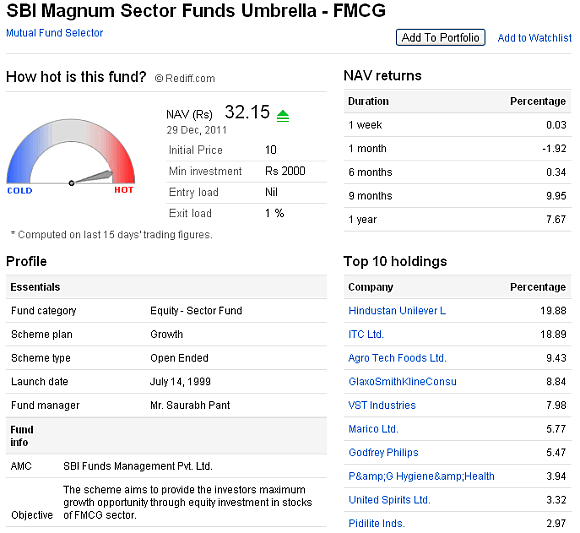
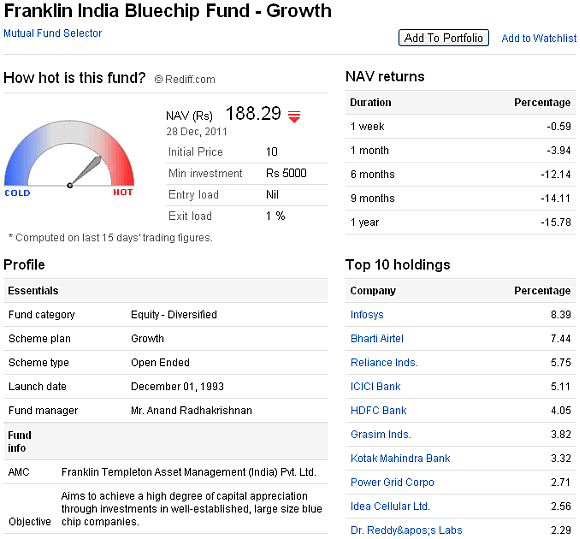
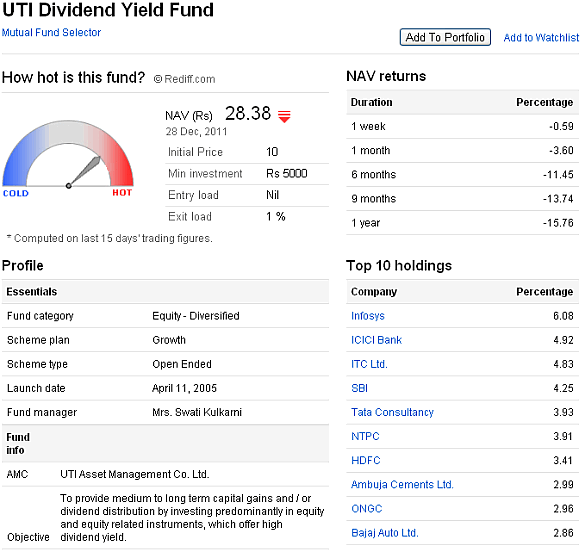
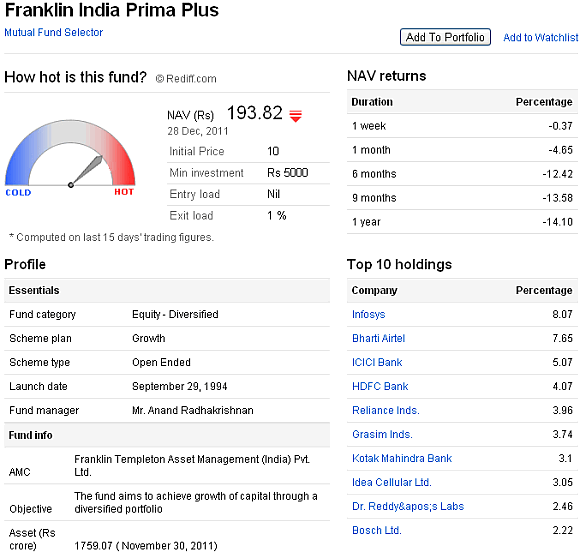
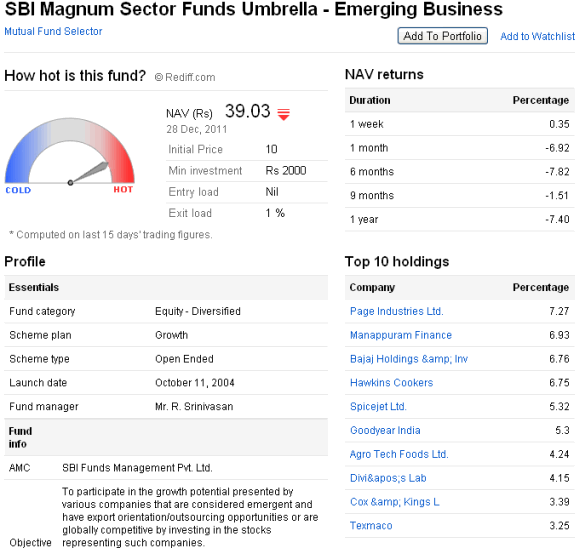
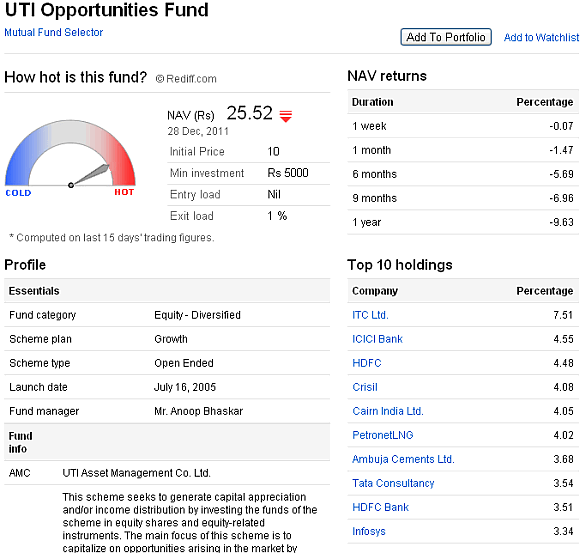
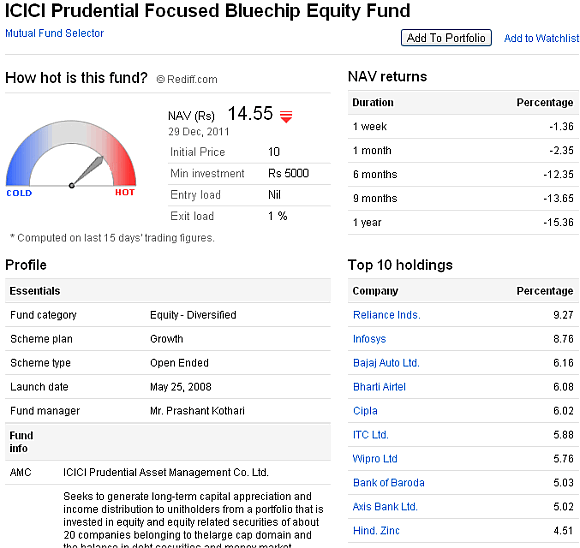
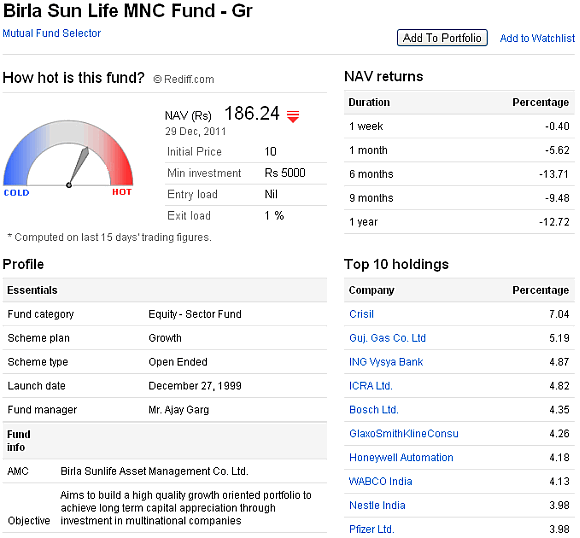
Comment
article